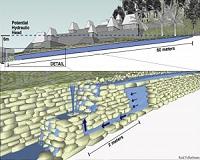| . |  |
. |
Bonn, Germany (SPX) May 06, 2010 Neurons communicate with one another via so-called action potentials. During an action potential, voltage-gated calcium channels are opened resulting in rapid calcium ion influx. Because of this tight coupling, fluorescent calcium indicator proteins can visualize action potentials. These proteins have two fluorescent subunits, one of which radiates yellow light and the other blue. When the proteins bind calcium, the proportion of yellow to blue light changes. Colour variation from blue light towards yellow thus reports different calcium levels - which is why the protein has been dubbed a "cameleon".
Measuring action potentials optically "The cameleon protein YC3.60 gives us the ability to measure action potentials not only in brain slices, but also in the intact brain. The molecule reacts quickly and sensitively and also captures changes in calcium concentrations occurring in rapid sequence," explains Mazahir Hasan from the Max Planck Institute for Medical Research. The scientists were able to investigate activity in single cells as well as in whole groups of nerve cells. "YC3.60 has therefore proven to be a suitable tool for studying nerve tissue at different levels: on the one hand, we can monitor the fluctuation of calcium to infer action potentials within nerve cells. And what is even more advantageous, we can simultaneously measure the activity of neural networks or entire brain regions," says Mazahir Hasan. Consequently, the next step the scientists want to do is to selectively introduce cameleon proteins into a specific cortical layer or into different types of nerve cells. "Then we may be in a position to understand how different nerve cells in brain circuits generate complex behaviours," states Mazahir Hasan hopefully.
Measuring without electrodes Moreover, cameleon proteins can be formed by cells themselves provided a corresponding section of DNA has been inserted into the genome in advance. In the experiments conducted by the scientists, viruses served as the vehicle for smuggling the genetic information for the cameleon proteins into the nerve cells. In two earlier studies, an international team of scientists headed by Mazahir Hasan were the first to demonstrate that similar genetic probes can successfully detect natural sensation (such as smell and touch) in the mammalian brain in the form of unique activity patterns (Hasan et al., 2004) and, more importantly, with single-cell, single-action-potential resolution (Wallace et al., 2008). In the current study, they have reached yet another major milestone as they demonstrate that the cameleon YC3.60 can be used to record activity from a large number of nerve cells during behaviour in freely moving mice. Additionally, it is well suited for recording activity from the same nerve cells in the same animals over a long time period and should help scientists to understand how network activity patterns form to code for different experiences and animal behaviour. These new advances, using light to study the brain, provide us with a unique opportunity to investigate how memories are formed and lost and, furthermore, when and where nerve cell activity patterns become altered as in the case of aging and also in neurological diseases such as Alzheimer's disease, Parkinson's disease and schizophrenia.
Share This Article With Planet Earth
Related Links Max Planck Institute for Medical Research All About Human Beings and How We Got To Be Here
 Maya Plumbing, First Pressurized Water Feature Found In New World
Maya Plumbing, First Pressurized Water Feature Found In New WorldUniversity Park PA (SPX) May 05, 2010 A water feature found in the Maya city of Palenque, Mexico, is the earliest known example of engineered water pressure in the new world, according to a collaboration between two Penn State researchers, an archaeologist and a hydrologist. How the Maya used the pressurized water is, however, still unknown. "Water pressure systems were previously thought to have entered the New World with the ... read more |
|
| The content herein, unless otherwise known to be public domain, are Copyright 1995-2010 - SpaceDaily. AFP and UPI Wire Stories are copyright Agence France-Presse and United Press International. ESA Portal Reports are copyright European Space Agency. All NASA sourced material is public domain. Additional copyrights may apply in whole or part to other bona fide parties. Advertising does not imply endorsement,agreement or approval of any opinions, statements or information provided by SpaceDaily on any Web page published or hosted by SpaceDaily. Privacy Statement |